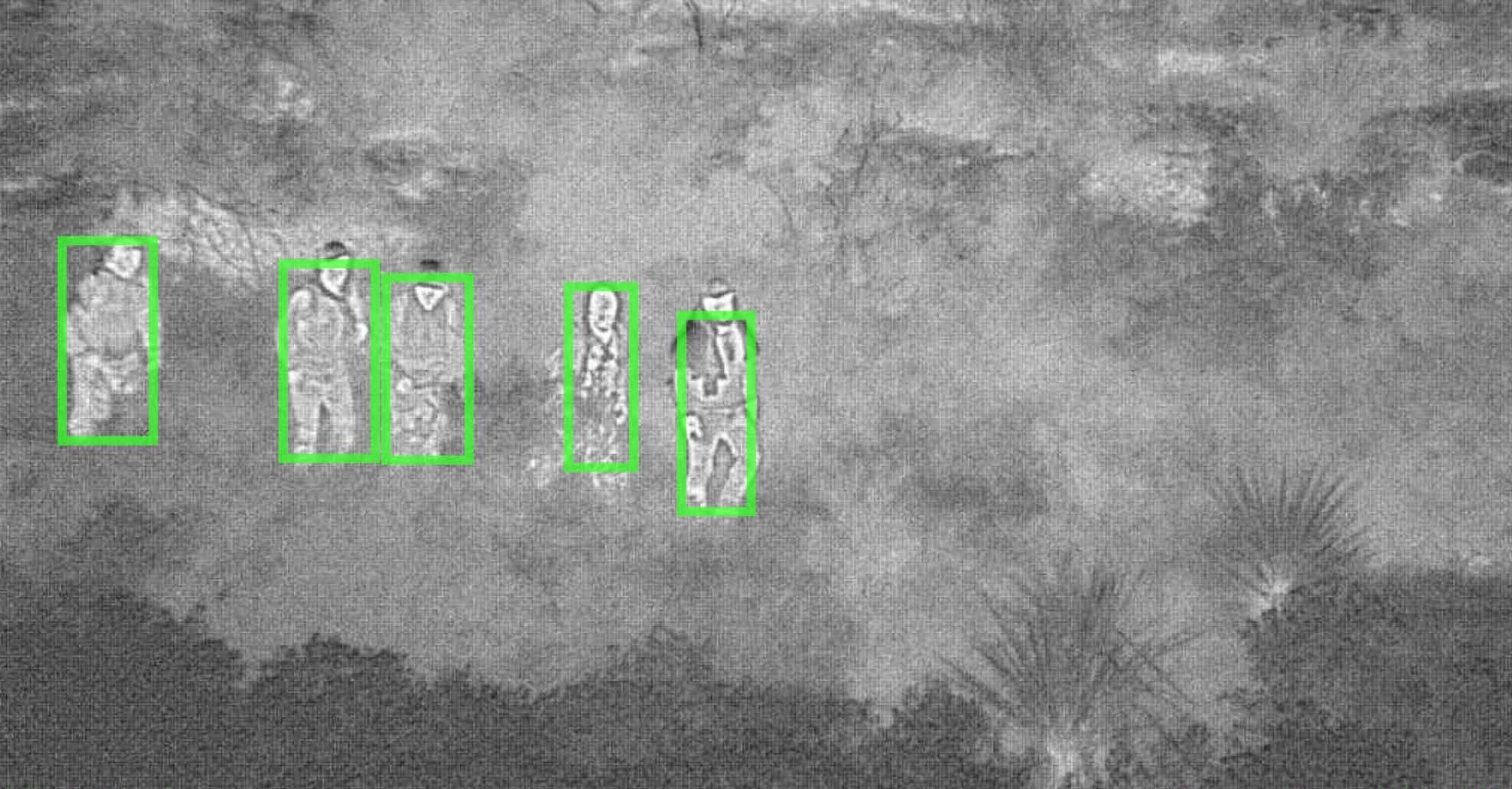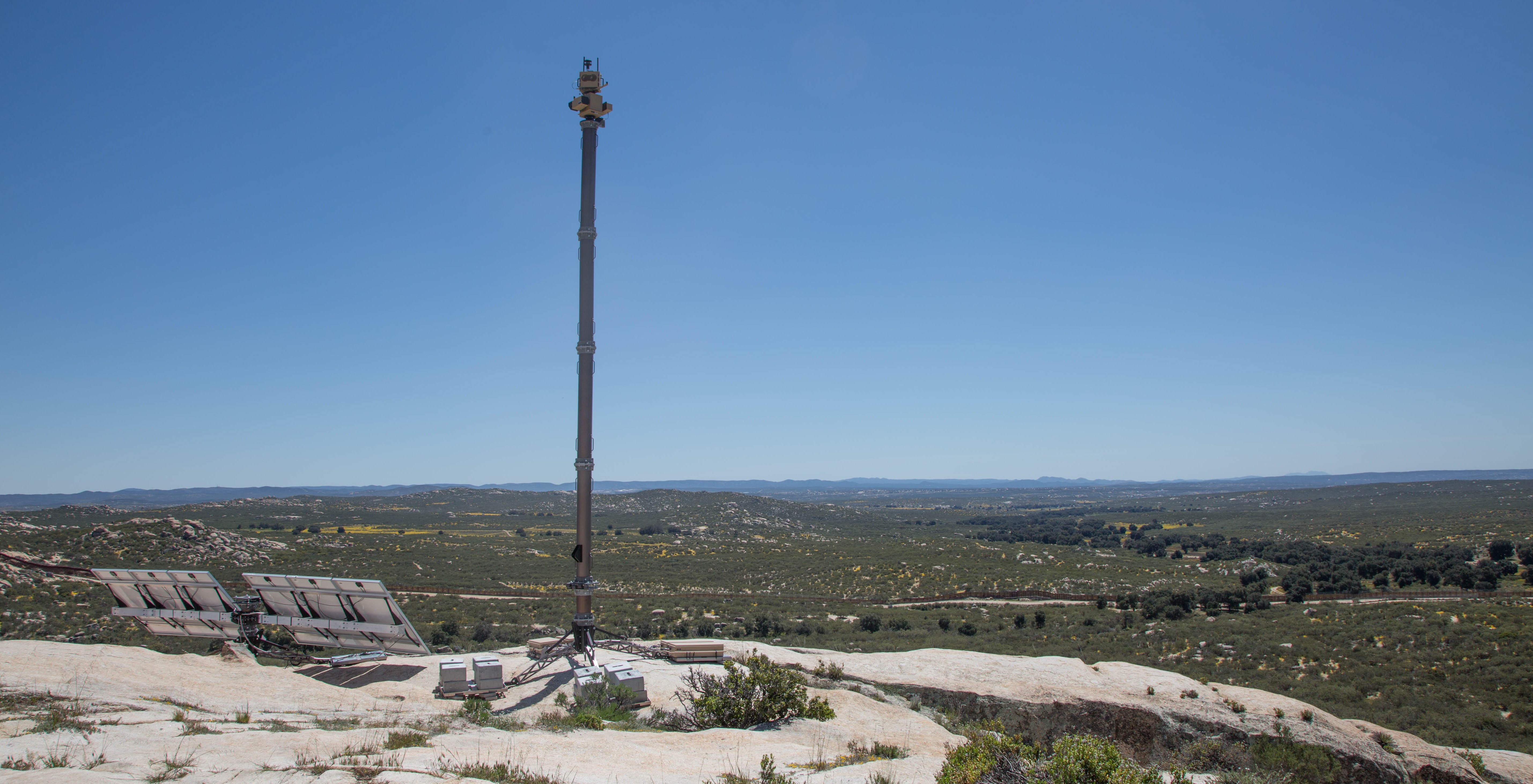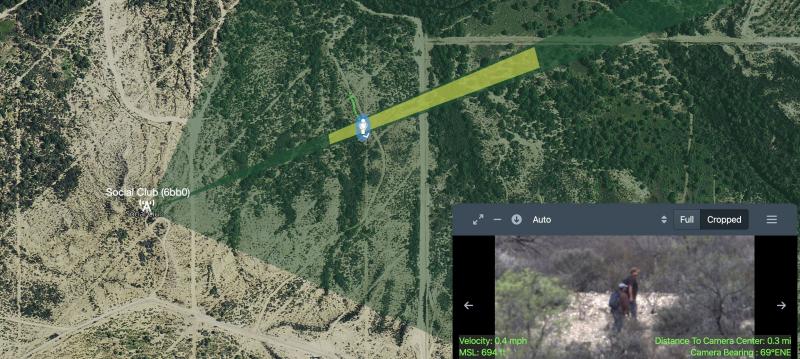
A Watchful Eye

Screen capture image from one of the towers shows illegal aliens making their way through the dense brush not far from the Rio Grande. This is what Border Patrol agents see on their devices sent from a recent use of the autonomous surveillance towers near Laredo, Texas. CBP photo
Typically, Supervisory Border Patrol Agent Richard Vargas works alone about 20 miles or more just outside of Laredo, Texas. It’s an area that follows the Rio Grande for more than 50 miles, a part of the border with Mexico that is a thick tangle of brush, trees, cactus and thorn thickets that sometimes has barely enough dirt road for an all-terrain vehicle, or ATV.
“We don’t have river roads,” Vargas said. “It’s a bunch of dense brush. We work primarily on private ranchlands. These ranchers just don’t have roads down here. Ninety percent of the work we do is on foot or on ATVs.”
With dense vegetation and vast tracts of isolated ranch land, the region attracts the human and drug smugglers to try their chances. “The groups for us range from 10 to 100 people,” all hoping to evade Border Patrol detection, he said.
But while Vargas might patrol part of the area by himself, he’s not alone; he’s got a partner. A partner that never sleeps, never needs to take a coffee break, never even blinks. This partner isn’t someone; it’s some thing: autonomous surveillance towers.

near Laredo, Texas. Photo by Supervisory Border
Patrol Agent Dustin Smith
“These towers have been amazing for us, a great asset because they can see what we can’t see on the ground,” he said, adding that the towers complement their personnel out in the field by keeping an eye on things when agents are tied down with one of these large groups of 100 – or even more – illegal aliens who often serve as a distraction for more nefarious activities, such as drug smuggling. “There’s been many times when we worked a group or two and a tower picked up a third group down or up river that we were able to respond to as well. It’s been a huge difference maker.”
In addition, the towers give agents a visual indication of what they will encounter when they get to a group, such as whether anyone in the group is carrying weapons.
“If they’re armed, or if they’re carrying dope, rather than just immigrants trying to get in, it’s letting us know ahead of time – before we get to the group – what these guys are all about,” Vargas said. “And that’s a really big deal.”
Each of the towers, reaching 33 feet in height and capable of “seeing” an area approximately three miles in diameter, fits in the back of three trucks and sets up in just a couple of hours, giving great mobility to the technology so Border Patrol agents can more quickly respond to areas that need immediate attention. Using artificial intelligence, the towers continuously monitor wherever is needed, sorting out what are real concerns and what comes back as a false positive. They have day and night cameras that turn and “look” at the area where the item of interest originates. The towers also “hand off” from one to the other. If a group goes out of the “sight” of one tower, artificial intelligence tells the next tower along the way to pick it, keeping the electronic eyes on the situation at all times. In fact, the towers can spot activity in Mexico when groups might be staging up a border incursion, allowing agents to get ready well before anyone starts to make their way across the border.
“There’s a radar on them that’s constantly scanning,” said Gail Viscarra, towers program manager at the Border Patrol’s headquarters in Washington, D.C. “When the radar detects an item of interest, such as people or a vehicle, it will start tracking it and alert an agent.”
“The response time from target identification to suspect apprehension dramatically decreased,” said Supervisory Border Patrol Agent Dustin Smith, deputy program manager also at headquarters. “It frees up personnel, so agents can return to the field to patrol and continue doing their job.”
The artificial intelligence eliminates the need for multiple people to constantly monitor what comes in on video screens, sending immediate alerts directly to agents in the field on their phones or tablets. The towers job is to detect, identify, and track targets in those areas that are most likely for incursions to occur.

“Before, if you’re an operator of a scope truck or a camera operator for a fixed tower, that person’s responsibility is to constantly scan, which is a very time-consuming and tiring effort,” for what can be up to 10 hours a day, Smith said. “What this does is take that constant awareness away from the human. When it picks up a radar hit, it pans around. When it picks up movement on the camera, the [artificial intelligence] deciphers what it is,” sorting out things such as wildlife and livestock from people in the field. After the target is validated, it continues to follow it.
The towers pan randomly, so scouts for smugglers can’t anticipate where they might be looking, and since the technology responds to radar hits, there are few blind spots someone might try to exploit. They’re being paired with team awareness kits being sent to the agents to create a fully integrated system. Smith expects that – while a change from some of the old ways – the changes will be welcomed by those on the front lines.
“Once it integrates with a few pieces of technology, it will be completely different than what we’ve done in the past,” he said.
Another big benefit for agents in the field is the towers run on solar power. That eliminates the need for having to put in infrastructure, such as power lines or fuel systems, which complicate the Border Patrol’s agreements with many of the private ranchland owners, national parks, and Native Americans’ tribal lands where the Border Patrol must work. While landowners generally welcome the Border Patrol’s vigilance on their private property, they don’t want their land torn up or potentially damaged by something like a fuel spill or new roads to support a power source. The towers’ self-contained, 100% clean energy signature eliminates those worries.
“You don’t have to do as much environmental work to get them approved,” Viscarra said. “You’re not digging or scraping the ground or having to put in any kind of footers. They sit on top of the ground.”
“It is state-of-the-art technology that provides an extra layer of security, and some landowners have requested the technology themselves,” said Deputy Chief Patrol Agent Joel Martinez from Laredo, Texas, who has to work out agreements with private landowners to put them on the land. “Once they see how small of a footprint they have on the environment and what they do, they’re actually calling us and asking for them.”

100% clean energy and reduce the need for
infrastructure, such as roads and electrical
lines or fuel supplies, which can cause
environmental damage. CBP photo
He added the towers already are also pretty popular with his agents. “There are no surprises. The agents know exactly what they’re walking into. It’s a game changer.”
Martinez emphasized that while the autonomous surveillance towers give his agents a leg up against the human and drug smugglers, they don’t replace the work the people with boots on the ground still need to do. “It’s a force multiplier that allows us to use our agents more effectively and efficiently,” he said.
Agents have spent the last two years putting the system through its real-world paces in Texas and in southern California. About 60 towers were placed at those locations, and it’s already scored several success stories, such as last November when the system spotted a group of 25 people near what’s called “Superman Hill” in the Laredo sector. One tower tracked the suspects until it couldn’t see it any longer and handed off to another tower, which quickly sent coordinates to nearby agents, who picked up 19 members of the group in the dense brush within about 15 minutes, while the other six beat a hasty retreat back across the Rio Grande.
“The capability of the tower was exceptional,” Martinez said. “The overlapping radar views provided great coverage for this area.”
Successes such as these prompted the Border Patrol to move it from a testing category to a more permanent “program of record.” Two hundred towers in total will be deployed over the next couple of years, beefing up and complementing other technologies along the border, as well as the physical barrier being constructed and the people who keep a watchful eye along America’s frontiers.
For veteran agents such as Vargas, the autonomous surveillance towers make all the difference when faced with a border that is constantly being tested. In his nearly two decades in the Border Patrol, Vargas has seen many pieces of technology, some helpful, some not so much. He said these towers are the real deal for agents like him, who have to work the thick underbrush and desolate desert areas that make up the U.S. southern border.
“I’ve been in the patrol almost 19 years, and this is probably one of the best pieces of technology we have ever received,” Vargas said. “They’ve been an excellent asset, and we’re hoping to get more.”


